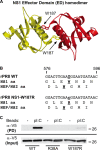Contribution of NS1 effector domain dimerization to influenza A virus replication and virulence
- PMID: 22993153
- PMCID: PMC3497675
- DOI: 10.1128/JVI.02237-12
Contribution of NS1 effector domain dimerization to influenza A virus replication and virulence
Abstract
Conserved tryptophan-187 facilitates homodimerization of the influenza A virus NS1 protein effector domain. We generated a mutant influenza virus strain expressing NS1-W187R to destabilize this self-interaction. NS1-W187R protein exhibited lower double-stranded RNA (dsRNA)-binding activity, showed a temporal redistribution during infection, and was minimally compromised for interferon antagonism. The mutant virus replicated similarly to the wild type in vitro, but it was slightly attenuated for replication in mice, causing notably reduced morbidity and mortality. These data suggest biological relevance for the W187-mediated homotypic interaction of NS1.
Figures



References
-
- Cheng A, Wong SM, Yuan YA. 2009. Structural basis for dsRNA recognition by NS1 protein of influenza A virus. Cell Res. 19:187–195 - PubMed
-
- DeLano WL. 2002. The PyMOL molecular graphics system. DeLano Scientific, Palo Alto, CA
Publication types
MeSH terms
Substances
Grants and funding
LinkOut - more resources
Full Text Sources

